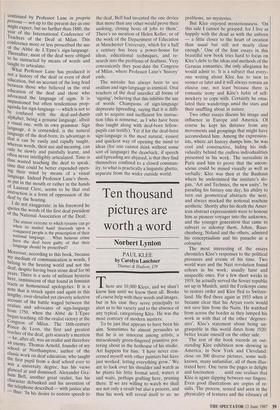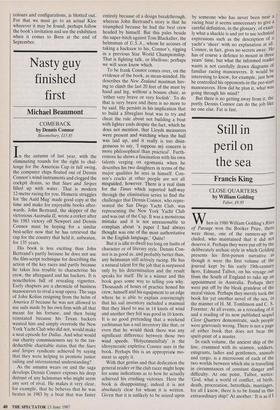Ten thousand pictures are worth a word
Norbert Lynton
PAUL KLEE by Carolyn Lanchner Thames & Hudson, £39 There are 10,000 Klees, and we shan't know him until we know them all. Books of course help with their words and images, but in his case they serve principally to alert us to his variety and to the absence of any typical, categorising Klee. He was the most contrary of modern masters.
To be just that appears to have been his aim. Sometimes he almost persuades us that he is an innocent among artists, a miraculously green-fingered primitive pot- tering about in the hothouse of his studio. Art happens for him. 'I have never con- cerned myself with other painters but have just worked, letting everything grow.' We are to look over his shoulder and watch as he plants his little formal seed, waters it and waits, perhaps grafting here, pruning there. If we are willing to watch we shall see not only a result but also a process, and thus his work will reveal itself to us: no problems, no mysteries.
But Klee enjoyed mysteriousness. 'On this side I cannot be grasped, for I live as happily with the dead as with the unborn — a little closer to the heart of creation than usual but still not nearly close enough.' One • of the four essays in this beautiful new book tries hard to focus on Klee's debt to the ideas and methods of the German romantics, the only allegiance he would admit to. It is a subject that every- one writing about Klee has to turn to sooner or later and it will always remain an elusive one, not least because there is romantic irony and Klee's habit of self- mockery to cope with. Certainly he emu- lated their wanderings amid the stars and their snuffling about in nature.
Two other essays discuss his image and influence in Europe and America. Of course he kept his distance from any movements and groupings that might have accomodated him. Among the expression- ists, where art history dumps him, he was cool and constructive, hiding his indi- viduality behind the endless individualities presented in his work. The surrealists in Paris used him to prove that the uncon- scious could be mined visually as well as verbally; Klee was then at the Bauhaus where he undermined the institute's slo- gan, 'Art and Technics, the new unity', by parading his fantasy one day, his ability to turn out geometrical abstracts the next, and always mocked the notional machine aesthetic. Shortly after his death the Amer- ican abstract expressionists were to honour him as pioneer voyager into the unknown, and the younger generation that came to subvert or sidestep them, Johns, Raus- chenberg, Noland and the others, admired his conceptualism and his panache as a colourist.
The most interesting of the essays chronicles Klee's responses to the political pressures and events of his time. Two world wars and the Nazi revolution found echoes in his work, usually faint and unspecific ones. For a few short weeks in 1919, he actually served the Soviet republic set up in Munich, until the Freikorps came to restore order and Klee fled to Switzer- land. He fled there again in 1933 when it became clear that his Aryan roots would not save him from the Nazis. He watched from across the border as they lumped his work in with that of the other 'degener- ates'. Klee's statement about being un- graspable in this world dates from 1920: better locate oneself on the other side.
The rest of the book records an out- standing Klee exhibition now showing in America, in New York and Cleveland:
close on 300 diverse pictures, some well- known, many unfamiliar, all of them illus- trated here. One turns the pages in delight and fascination . . . until one realises that Klee is again slipping between our fingers. Even good illustrations are copies of re- sults. The process, sensed and seen in the physicality of textures and the vibrancy of colours and configurations, is blotted out. For that we must go to an actual Klee wherever it may be found, perhaps follow the book's invitation and see the exhibition when it comes to Bern at the end of September.




























































 Previous page
Previous page